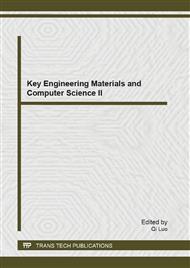[1]
M.T. Averbuch-Pouchat, A.Durif, Topics in Phosphate Chemistry, first ed., World Scientific, Singapore 1996.
Google Scholar
[2]
P. Sundaramoorthi, G. Kanchana, S. Kalainathan, Spectrochemic Acta A. 69, (2008), p.1154–1159.
Google Scholar
[3]
S. Suri, K.K. Bamzai, V. Singh, J. Therm. Anal. Calorim. 105,(1), (2011), pp.229-238.
Google Scholar
[4]
D. Nallamuthu, P. Selvarajan, T. H. Freeda, Physica B-Conden. Matter. 405(24),(2010), pp.4908-4913.
DOI: 10.1016/j.physb.2010.09.030
Google Scholar
[5]
S. Suri, K.K. Bamzai, V. Singh, Ferroelectics. 423,(2011), pp.94-104.
Google Scholar
[6]
W. Huang, D.E. Day, M.N. Rahaman. J. Amer. Ceram. Soc., 90(3), (2007), pp.838-844.
Google Scholar
[7]
E. Banks, R/ Chianelli, F.Pintchovsky, J. Cryst. Growth, 18(2), (1973), pp.185-190. [8] C. Duan, X. Wu, H. Chen, X. Yang, J. Zhao, Wuji Cailiao Xuebao/J. Inorg. Mater., 20(5), (2005), pp.1043-1048.
Google Scholar
[9]
C. Kato, K. Fujita, K. Matsuda, Nippon Kagaku Kaishi / Chem. Soc. Japan Chem. Ind. Chem. J., (7), (1996), pp.636-637.
Google Scholar
[10]
T. Nishino, N. Ishizawa, Nippon Seramikkusu Kyokai Gakujutsu Ronbunshi, J. Ceram. Soc. Japan, 108(6), (2000), pp.575-580.
DOI: 10.2109/jcersj.108.1262_944
Google Scholar
[11]
P. Parhi, A.R. Ray, A.Ramanan, J. Amer. Ceram. Soc., 90(4), (2007), pp.1237-1242.
Google Scholar
[12]
K.C. Hebber, S.M. Dharma Prakash, P. Mohan Rao, Bull Mater Sci. 14,(1991), p.1219–23.
Google Scholar
[13]
D.Y. Pan, D.R. Yuan, H.Q. Sun, S.Y. Guo, X.Q. Wang, X.L. Duan, C.N. Luan, Z.F. Li. Cryst. Res. Technol.,41,(2006), p.236–8.
Google Scholar
[14]
S. K. Arora, T. R. Trivedi, A.T. Oza, V.A. Patel. Acta Materialia, 49(11), (2001), pp.2103-2107.
DOI: 10.1016/s1359-6454(01)00024-6
Google Scholar
[15]
S.K. Arora, T.R. Trivedi, V.A. Patel. Scrip. Mater., 47(10), (2002), pp.643-647.
Google Scholar
[16]
T. BenChaabane, L. Smiri, A. Bulou, Solid State Sci., 6(2), (2004), pp.197-204.
Google Scholar
[17]
F. Wang, G. Xu, Z. Zhang, Mater. Lett., 59(7), (2005), pp.808-812.
Google Scholar
[18]
H.A. Höppe, M. Daub, O. Oeckler, Solid State Sci., 1(8),(2009), pp.1484-1488.
Google Scholar
[19]
G.Herzberg, Molekülspektren und Molekülstruktur. I. Zweiatomige Moleküle, Steinkopff, Dresden, 1939.
Google Scholar
[20]
N. B. Colthup, L.H. Daly, S.E. Wiberley, Introduction to Infrared and Raman Spectroscopy Academic Press, New York 1964.
DOI: 10.1126/science.146.3649.1289
Google Scholar
[21]
B. D.Cullity, Elements of X-ray Diffraction, second ed., Addison-Wesley, Massachusetts,1977.
Google Scholar


